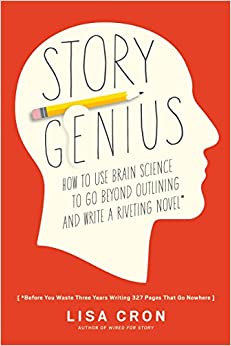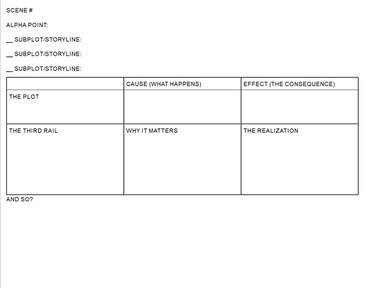|
Last week I got back to work on my novel-in-progress after taking several weeks off to focus on other matters. There’s been some stuff going on, ya know? There still is, but at least I’m able to inhabit islands of concentration here and there. Of course, it always takes time to get up to speed on something you’ve set aside, and that’s especially true in this case because I’m using a completely different (for me) approach with this writing project—one that requires a great deal of thought and patience.  In my novel project, I'm using the method detailed in this book In my novel project, I'm using the method detailed in this book As I ease back into this painstaking process, I can’t help thinking it might serve as a model for how to approach life in general. I’ll elaborate on that in a moment, but first a little more about the writing part. The method I’m following was developed by author Lisa Cron and detailed in her 2016 book Story Genius: How to Use Brain Science to Go Beyond Outlining and Write a Riveting Novel (Before You Waste Three Years Writing 327 Pages That Go Nowhere). What aspiring author wouldn’t be seduced by that title? Shave three years off the process and end up with a riveting novel? Sign me up!  Cron advocates the use of scene cards such as this one to "blueprint" your novel, scene by scene. Cron advocates the use of scene cards such as this one to "blueprint" your novel, scene by scene. But it turns out the secret isn’t to power through, wildly racking up word counts. It’s to carefully “blueprint” every single scene, stifling the impulse to start writing the scene until you’ve answered several key questions. And I mean really answered them thoroughly, sometimes with pages of brainstorming ideas that will never make it into the manuscript. Questions such as:
Whew! See what I mean about a lot to think about? All this could easily be overwhelming if you had to lay out the whole novel, scene by scene, before writing a single word. But it doesn’t work that way. You draft an opening scene—realizing it’s only a draft that will be revised many times—and an ending scene, again knowing it, too, will likely change. Then you methodically fill the space between beginning and end, working in chunks of scenes. Map out a chunk, blueprinting scene by scene. Write those scenes. Then blueprint another chunk of scenes, one at a time, and write those. From time to time, spiral back to the scenes you’ve already written, and layer in new information, new setups and storylines that emerge as you go, always keeping the end in sight. Now, how does this apply to life in general? Obviously we can’t spiral back and rewrite parts of our lives, much as we might wish we could! Still, I do see a few parallels. The first is that in the Story Genius method, the focus is on each scene. Instead of getting overwhelmed by the idea of writing a whole novel, you zero in on the scene in front of you, examine it from several angles, and think it through before moving on. Kind of like focusing on what’s happening right here, right now, each day instead of letting your mind get stuck in the “If only . . .” of your past or fast-forwarding into the “What if . . .?” of the future. The idea isn’t to over-analyze each moment, but to be aware and focused on the here and now. Second, just as writers following Story Genius ask what their characters believe and why, we all can benefit from examining our beliefs and motivations. Where do they come from, and how trustworthy are those sources? How do our beliefs affect our worldview, and how do our experiences change them? Finally, unlike authors of novels, we can’t predict how our own stories will end. But we can keep in mind our ultimate goals and intentions and try to make sure every scene in our saga unfolds in a way that leads us in the direction we want to go.
11 Comments
Sally F Pobojewski
11/18/2020 07:03:34 am
I admire your discipline, Nancy. I am still struggling with figuring out my ultimate goals and intentions.
Reply
Nan
11/18/2020 07:13:41 am
Well, then, just keep going scene by scene! :-)
Reply
Nan
11/18/2020 03:32:35 pm
Hi Emma,
Reply
Sue Schneider
11/18/2020 02:02:15 pm
How intriguing! I appreciate your dedication to expand and grow with purpose.
Reply
Nan
11/19/2020 08:45:53 am
And I appreciate yours!
Reply
bex
11/18/2020 04:28:45 pm
Much of this method can also be helpful to do in advance of a predictable 'confrontation.' Not that I ever scripted any of those events exactly, but it was amazing how many of them followed one of the scenarios I'd anticipated. Strange but true!
Reply
Nan
11/19/2020 08:47:31 am
What an interesting observation. Probably true for any difficult conversation, whether confrontational or not. And we can all use a little help with those, eh?
Reply
Sandy McPeak
11/18/2020 06:05:30 pm
At first when I read the goal (write creatively) I was relieved that I don’t have to be creative or write a novel because I feel so uncreative. But then when you broke it down into more manageable chunks I could see how that takes some of the pressure off and encourages the process to start. As you said, that’s a good analogy for approaching bigger life goals.
Reply
Nan
11/19/2020 08:51:13 am
Breaking big jobs down into smaller chunks is the only way I ever seem to get anything done, whether it's writing a book or cleaning out the cabinet under the kitchen sink (which I just did -- yay me!).
Reply
12/8/2020 11:09:33 am
This is definitely a mind-bending or brain-bending method of writing a book. I believe I do a lot of this when I am in the creating stages, but more in my head than on paper. It reminds me of one of my favorite sayings, "There is only one way to eat an elephant, one bite at a time." Desmond Tutu (I just googled that.)
Reply
Leave a Reply. |
Written from the heart,
from the heart of the woods Read the introduction to HeartWood here.
Available now!Author
Nan Sanders Pokerwinski, a former journalist, writes memoir and personal essays, makes collages and likes to play outside. She lives in West Michigan with her husband, Ray. Archives
April 2022
Categories
All
|







 RSS Feed
RSS Feed